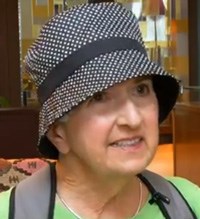






Elaine Kiourtsis, 76, of Powell, Ohio, is one of the first patients to receive the novel treatment at the OSUCCC - James. A few months earlier, she was diagnosed with a dangerous type of brain tumour called glioblastoma. Following surgery, chemotherapy and radiation, doctors gave her the electrical "helmet" she wears up to 18 hours a day that bombards her brain with electrical currents. At night, she plugs the device into the wall while she sleeps, and during the day, the device is powered by battery packs. Patients say the machine is silent and easy to use.
"The electric currents interrupt the ability of cells to divide, causing their death and tumour shrinkage," says Dr. Robert Cavaliere, a neuro-oncologist at the OSUCCC - James. "The studies that have been performed suggest that this therapy is equivalent to chemotherapy in terms of outcomes."
Glioblastoma, which is diagnosed in about 10,000 Americans each year, is both the deadliest and the most common form of primary brain tumour in the United States, according to the American Cancer Society.
Median overall survival time from initial diagnosis for patients with this type of brain cancer is 15 months with optimal treatment, and average survival from the time the tumour returns is only 3 to 5 months without additional effective treatment. The disease is widely recognised as one of the deadliest forms of cancer.
Novocure, a commercial oncology company developed the device, which uses Tumour Treating Fields (TTFields) therapy for patients with recurrent glioblastoma. Approved by the US Food and Drug Administration in 2011, the device is being used by doctors at 15 clinical centres nationwide.
Cavaliere says the device has slowed the growth of brain tumours, and, in some cases, has been shown to shrink them. In addition, the electrical currents that kill cancer cells don't hurt healthy ones - and it can work just as well as chemotherapy, but without serious side effects.
Right now the device is being used only on brain tumours, but there are plans to test the technology on other types of cancer, says Cavaliere. While the device is being used only for patients whose cancer has returned, studies are also underway to see if it might work as an option immediately after diagnosis.
New treatment approaches for glioblastoma are desperately needed, particularly therapies that are less toxic, says Cavaliere.
"This is a novel approach that is less risky and has fewer side effects than traditional chemotherapies that we have been using up until now to treat these tumours," says Cavaliere. "Patients treated with chemotherapy frequently experience some nausea or vomiting and they can have problems with bleeding and infections, but we don't see those kinds of problems with this device."
Source: Ohio State University